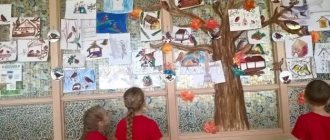Extracurricular event “Tolerance is the path to peace”
Extracurricular activity
“Tolerance is the path to peace”
(4th grade)
Topic: Tolerance is the path to peace.
Purpose: to define tolerance;
determine the qualities of a tolerant person;
continue to familiarize children with the concept of “tolerant attitude”;
continue to develop a tolerant, merciful, tolerant attitude towards peers and adults;
continue to develop the desire to provide help and be ready to accept it;
develop intolerance towards any type of violence.
Equipment: cards with inscriptions (names, conceptual apparatus), cards with provisions from world religions (for work in pairs), envelopes for work in groups (each envelope contains a list with various human qualities), “magic chair” and “magic wand” ”, musical accompaniment (children’s songs about friendship - “A smile will make everyone brighter”, “It’s fun to walk together”, “Sunny circle”).
Progress of the lesson
Teacher
The world is the Universe. The world is our Earth. The world is our country. The world is our city. The world is our school. The world is me. How diverse the world around us is. We are all so different: adults and children, blondes and brunettes, kind and evil, plump and thin, bald and with pigtails, smart and not very smart. And we all must live and understand each other. There is such a beautiful word “tolerance” (the word appears on the board). How do you understand it?
Teacher
Tolerance is quite difficult to describe, perhaps because it is defined differently in different languages (definition cards are pinned to the board).
In English, tolerance is “the willingness and ability to accept a person without protest.”
In French, tolerance is “respect for the freedom of another, his way of thinking.”
In Arabic, tolerance is “forgiveness, forbearance, compassion, patience.”
In Persian, tolerance is “readiness for reconciliation.”
The Russian dictionary interprets tolerance as tolerance - the ability to tolerate something or someone, to tolerate a different way of life, different behavior, feelings, opinions, ideas. To be self-possessed, to be able to put up with the existence of someone, to take into account the opinions of others, to be lenient.
Teacher
Now we will work in pairs . Each couple has provisions on the table taken from world religions. Think about what each religion says:
- “Don’t do to someone else what hurts you.”
- “In everything that you want people to do to you, do so to them.”
- “Consider your neighbor’s success your success and your neighbor’s loss your loss.”
- “In happiness and suffering, in joy and sorrow, we must treat all beings as we treat ourselves.”
Teacher
Express these thoughts in your own words.
What is the general meaning of these statements?
Of course, guys, everything is true: “People should be lenient with each other, more tolerant, respect the opinions of others. They must be tolerant of each other."
But tolerance must have a face! Tolerance must have some qualities of its own. What qualities do you think tolerance should have?
Let's try to characterize a person who has a tolerant attitude (work in groups).
So let's try it. You have an envelope on the tables for each group with different qualities of a person. Try to choose five qualities that, in your opinion, correspond to a tolerant person (the class is divided into groups into rows, an envelope is placed on the first desk of each row-group).
Envelope 1: condescension, gloating, lies, conflict, kindness, respect, understanding, peacefulness, heartlessness, compassion, generosity, tactlessness, forgiveness, rudeness, warmth.
Envelope 2: kindness, warmth, tolerance, boasting, equality, rudeness, mercy, arrogance, compassion, cooperation, respect, generosity, understanding, anger.
Envelope 3: peacefulness, heartlessness, forgiveness, equality, respect, mercy, tolerance, temper, dialogue, irritation, cordiality, conflict, compassion, generosity.
Teacher
Guys! Let's check what we have done (a representative of each group reads out the answer of his group, then cards with the qualities that are most often encountered are attached to the board).
Thus, guys, we have grown an associative bush for the concept of “tolerance”.
| kindness | peacefulness | compassion | tolerance | generosity |
| cordiality | tolerance | understanding | ||
| respect | ||||
| forgiveness | mercy |
Think about it, do we all have these qualities? Can we all calmly listen to each other? To support people in difficult times, to understand people who are different from us, to resolve conflicts peacefully?
Can we change ourselves? Can we cultivate in ourselves the qualities we are talking about today? How can we do this?
Teacher
To do this, you and I will play the game “Let’s give each other compliments.”
Let us prove to each other that we are kind, understanding, tolerant people.
Each of us is pleased when he is praised, good, kind words are said about him, especially when it is deserved.
Any person wants to be loved and respected, appreciated and understood, and very often we simply need to hear kind words and wishes from the people around us. After all, this improves our mood and we are ready to share our joy and help others.
Now each of you who sits on the “magic chair” and picks up a magic wand will learn a lot of good things about yourself, and all the other guys will tell you about the positive qualities of this person.
For example: thank you for being such a kind and considerate friend; I like the way you laugh and joke; you are great at helping others.
Teacher
After all the children have been on the “magic chair,” the teacher discusses with the class what the children felt during the exercise:
- Did you like this yoke?
- Why?
- What new things have you learned about each other?
- Were the compliments the same or different?
- Why different?
Indeed, guys, every person is unique, every person is an individual, a person with his own characteristics. If we were all the same, life in the world would simply not be interesting.
Teacher
And finally, listen to these lines of A. Usachev’s poem “The Amazing Dwarf”.
There was an amazing house by the river. An amazing gnome lived in that house. His beard grew to the floor, and in that beard lived a Star.
This dwarf knew neither worries nor worries. The star illuminated the whole house and lit the stove, and cooked porridge, and told him fairy tales before bed...
And the dwarf scratched his beard with admiration, Which was, of course, pleasing to the Star. She fed only on crumbs of bread, and at night she flew to the sky for a walk.
So the years and centuries went by slowly... But one day the flour in the house ran out. And the gnome, having said goodbye to the hatched stove, went to the city across the river at dawn.
And in that city they didn’t wear beards.
- Ha-ha, Ho-ho-ho! - the people began to laugh - What a scarecrow! - everyone told him. And the dwarf got scared.
And he shaved his beard.
And his beard fell to the floor, And then his star set. There is now an ordinary house near the river. An ordinary gnome lives in this house.
His beard grew again, but the Star never returned to him.
Yes, guys, you always need to remember, we are all very different, each has its own characteristics, not to mention the inner world of each person. We must respect the individuality of each person, because we are all people, we have differences, but each of us is not the same and is needed by everyone else.
Unfortunately, people are not always tolerant of each other, but I hope that the time will come when all people will treat each other with respect, and no one will offend anyone. Each person will have his own beliefs, will defend his point of view, and all people will learn to negotiate, and will not fight, swear, or conflict.
Let your star always live with you, amazing, unique, independent and friendly.
Homework.
Creative work – Image of tolerance.
Teacher
We have already given the characteristics of a person who has a tolerant attitude. Now let's try to create an image of tolerance (the kids need to draw an image, make an applique, make a composition from plasticine, use photographs, soft toys or any other materials).
And remember that on earth small and big, fat and thin, white and black, cats and dogs, adults and children, Africa and Eurasia should be friends... they should be able to negotiate with each other.
And at the next class hour we will see what images you have created. Each of you will be able to defend your image of tolerance.
Applications
Cards with definitions of the concept of “tolerance”:
In English, tolerance is “the willingness and ability to accept a person without protest.”
In French, tolerance is “respect for the freedom of another, his way of thinking.”
In Arabic, tolerance is “forgiveness, forbearance, compassion, patience.”
In Persian, tolerance is “readiness for reconciliation.”
The Russian dictionary interprets tolerance as tolerance - the ability to tolerate something or someone, to tolerate a different way of life, different behavior, feelings, opinions, ideas.
Cards with statements from world religions
(for working in pairs):
- Don’t do to others what hurts you.”
- “In everything that you want people to do to you, do so to them.”
- “Consider your neighbor’s success your success and your neighbor’s loss your loss.”
- “In happiness and suffering, in joy and sorrow, we must treat all beings as we treat ourselves.”
Envelopes for working in groups (each envelope contains a list with various human qualities):
Envelope 1: condescension, gloating, lies, conflict, kindness, respect, understanding, peacefulness, heartlessness, compassion, generosity, tactlessness.
Envelope 2: kindness, warmth, boasting, equality, rudeness, mercy, arrogance, compassion, cooperation, respect, generosity.
Envelope 3: peacefulness, heartlessness, forgiveness, equality, respect, mercy, temper, dialogue, irritation, cordiality, conflict, generosity.
Cards with inscriptions of the qualities of a tolerant person
(for associative bush):
tolerance , forbearance, kindness, respect, understanding, peacefulness, compassion, generosity, cordiality, equality, mercy, cooperation, tolerance, forgiveness, dialogue.
Literature:
1. Brief philosophical encyclopedia M., Progress. Encyclopedia, 1994
2. Vulfov B.Z. “Education of tolerance, essence and means” Out-of-school student-2002 No. 6.
3. Declaration of principles of tolerance. Approved by resolution 5.61 of the General Conference of UNESCO on November 16, 1995.
4. Rozhkov M.I., Bayborodova Ya.V., Education of tolerance among schoolchildren. Yaroslavl 2005
Extracurricular event “Tolerance Day”
“Event dedicated to the Day of Tolerance”
Extracurricular event “Tolerance Day” The purpose of this event:
- introducing children to the concept of “tolerance, tolerant attitude”,
- fostering respect and kindness towards other people,
- development of communication skills.
Lesson plan
Introduction,
updating existing knowledge:
Guys, today we celebrate Tolerance Day.
- What kind of word is this – tolerance?
- What traits should a tolerant person have?
- he must be attentive and kind, be able to communicate with people, and express his thoughts well. People differ from each other in nationality, habits, clothing, but they live together and we must respect young and old, healthy and sick, poor and rich.
- It is necessary for every person to develop his abilities, know a lot and be able to do so, so that he can become useful and necessary to our country.
- How else can we call today's holiday? (Day of mutual understanding, mutual acceptance, mutual trust.)
- Why do you think we have such a holiday today? (Because today – November 16th – is International Day of Tolerance.)
- Do you think you yourself are tolerant people? (Not really.)
- But it seems to me that you are all kind, understanding, tolerant.
And now I will show it to you, and you will help me.
I. Exercise. "Compliments"
Each of us is pleased when he is praised, good, kind words are said about him, especially when it is deserved.
Any person wants to be loved and respected, appreciated and understood, and very often we simply need to hear kind words and wishes from the people around us. After all, this improves our mood and we are ready to share our joy and help others.
Now each of you who sits on a magic chair and picks up a magic wand will learn a lot of good things about yourself, and all the other guys will tell you about the positive qualities of this person.
After all the children have been on the “magic chair,” the teacher discusses with the class what the children felt during the exercise.
- Did you enjoy this exercise?
- Why?
- What new things have you learned about each other?
- Were the compliments the same or different?
- Why different?
Indeed, guys, every person is unique, an individual. A person with his own characteristics. If we were all the same, life in the world would simply not be interesting.
II. Conversation in a circle.
Children sit in a circle with the teacher.
— Often children who study in the same class for several years know very little about each other, do not know who is interested in what, who likes what and what they don’t like. When you know a person, you can show attention to him and compare his interests with yours. Trying to understand a person who is completely different from you, showing interest in him, and if necessary, tolerance, is not easy, because you also need to know yourself well, have an idea of yourself as an individual. We must learn to live without infringing on both our interests and the interests of other people.
III. Exercise. "Magic Microphone"
Everyone who gets a microphone in a circle answers two questions
- Your hobby (what do you like to do?)
- What are you dreaming about?
- Have you learned anything new about your friends?
- What new have you learned?
- What surprised you, what did you like?
Now you can share with your friends your interests, skills, dreams, not only in your activities.
IV. Exercise. "Draw yourself"
All children receive a person template. Based on this template, they draw themselves, adding their own individual characteristics.
Discussion follows.
- What do all people have in common? (head, arms, legs...)
- What is the difference? (clothes, hair color, hairstyle, eye color.)
Yes, guys, we are all very different, each has its own characteristics, not to mention the inner world of each person. We must respect the individuality of each person, because we are all people, we have differences, but each of us is not the same and is needed by everyone else.
V. Exercise. "Outcast"
The teacher tells each child “in the ear” the name of one animal (cat, dog, cow, frog). It is important to divide the children into 4 approximately equal groups. One, usually the most mischievous one, is given the word crow.
Assignment for children: Without saying the word that I told you, but by saying only the sounds that these animals make, find “yours.”
Issues for discussion:
- How did you find out where your group is?
- Was it easy to find yours?
To the crow:
- Why didn't anyone pay attention to you?
- How did you feel?
- Why didn't you guys pay attention to him?
- Have you ever wanted to be in the crow's shoes?
- Is it hard to be different from everyone else?
- How will you treat such a person next time?
VI. Exercise. “They called, they call, they will call...”
The students sit in a circle and each one in turn, starting with the leader, says:
“When I was very little, my name was Vovochka, now at school they call me Volodya, and when I grow up, they will call me Vladimir Nikolaevich”
For many children, their name and patronymic, pronounced out loud, sound unusual, but at the same time they increase the child’s respect for himself and his parents, and provide guidance for the future, for growing up.
Conclusion:
We want to be treated with respect, to be called affectionately by name, but for this we need to understand ourselves, feel people’s mood, try not to offend anyone.
VII. Creative work. "Tolerant World"
Required equipment: felt-tip pens, glue sticks, Whatman paper, newspaper clippings and children's drawings of smiling faces of people (preferably of different races and nationalities).
Musical accompaniment: children's songs about friendship - “A smile will make everyone brighter”, “It’s fun to walk together”, “Sunny circle”, etc.
Children are encouraged to make a collage using clippings and drawings. After designing the collage wall newspaper, it is hung in the classroom or recreation area.
VIII. Lesson summary:
- Guys, I learned a lot about you today, and did you learn something new about each other?
- Why should we strive to learn new things about each other?
- Will our lesson today be useful to you in the future?
- Do you think our holiday was a success?
Unfortunately, people are not always tolerant of each other, but I hope that the time will come and the Day of Tolerance will not be celebrated, or rather it will be every day, all people will treat each other with respect, no one will offend anyone. Each person will have his own beliefs, will defend his beliefs, and all people will learn to negotiate, and will not fight, swear, or conflict.
CLASS HOUR “WHAT IS TOLERANCE?” (for middle classes)
Target:
introduce students to the concept of “tolerance”, the main features of a tolerant and intolerant personality; develop the ability to adequately and fully know oneself and other people.
Form:
“round table” with plot-role tasks and problematic issues.
Class progress
- Good afternoon. I would like to start our meeting with a conversation about the eternal, about love.
Music sounds and a fairy tale is told.
Once upon a time there lived a girl named Love on earth. She was bored living in the world without a girlfriend. So she turned to the old, gray-haired wizard who had lived a hundred years:
“Help me, grandfather, choose a girlfriend so that I can be friends with her throughout the life God has given me.”
The wizard thought and said:
- Come to me tomorrow morning, when the first birds sing and the dew has not yet dried...
In the morning, when the scarlet sun illuminated the earth, Love came to the appointed place... She came and saw: five beautiful girls standing, one more beautiful than the other.
“Choose,” said the wizard. - one is called Joy, the other is Luck, the third is Beauty, the fourth is Sadness, the fifth is Kindness.
“They are all beautiful,” said Lyubov. - I don’t know who to choose...
“You’re right,” answered the wizard, “they are all good, and you will meet them again in life, and maybe you will be friends, but choose one of them.” She will be your friend for the rest of your life.
Love came closer to the girls and looked into each one’s eyes. Love thought.
? Who would you choose? Why? {Music sounds and the continuation of the fairy tale): Love approached a girl named Kindness and extended his hand to her.
? Why did Love choose Kindness? {Answers).
Today our conversation is about tolerance. November 16 International
day of tolerance. Not everyone may be familiar with this word, and, at first glance, it sounds completely incomprehensible. But the meaning it carries is very important for the existence and development of human society.
A modern cultured person is not only an educated person, but a person who has a sense of self-respect and is respected by others. Tolerance is considered a sign of high spiritual and intellectual development of an individual, group, and society as a whole.
? What is tolerance? (Answers).
Let's summarize everything that has been said together. I depicted the word “tolerance” in the form of a sun. Let's depict your answers in the form of rays.
The term tolerance is explained as tolerance, desire and ability to establish and maintain communication with people.
Let's listen to how the word tolerance is defined in different languages around the globe. The message was prepared by...
The definition of the word “tolerance” in different languages of the globe sounds differently:
- in Spanish it means the ability to recognize ideas or opinions different from one's own;
- in French, an attitude in which it is accepted that others may think or act differently than oneself;
- in English - willingness to be tolerant, condescending;
- in Chinese - allow, accept, be generous towards others;
- in Arabic - forgiveness, forbearance, gentleness, mercy, compassion, benevolence, patience, affection for others;
- in Russian - the ability to endure something or someone (to be self-possessed, hardy, persistent, to be able to put up with the existence of something, someone).
?Which of the definitions appeals to you most? (Answers)
?Why do you think the definitions are different in different countries? (Answers).
?What unites these definitions? (Answers).
?Why is tolerance so important nowadays? (Answers)
The third millennium is gaining momentum. Progress moves inexorably forward. Technology has come to serve man. It would seem that life should become more measured and calmer. But more and more often we hear the words: refugee, victim of violence...
In today's society there is an active growth of extremism, aggressiveness, and expansion of conflict zones. These social phenomena especially affect young people, who, due to age characteristics, are characterized by maximalism and the desire for simple and quick solutions to complex social problems.
In recent years, among adolescents and young people there has been a catastrophic increase in all kinds of antisocial behavior. Juvenile crime continues to increase. The number of antisocial radical youth organizations is growing, involving inexperienced youth in extremist groups.
Every person does different things in life. In some situations he does the right thing and shows his good qualities, but sometimes it happens the other way around...
SCENE “THE TWO ROADS IN FRONT OF YOU. CHOOSE..."
A young man and his girlfriend were walking around the city. A poorly dressed elderly man was sitting on the curb. A tattered bag lay next to him. He moaned softly, and there were tears in his eyes.
“Wait, I’ll go to him,” the girl said.
- Do not even think about it. “It’s dirty, you’ll catch an infection,” the young man answered, squeezing her hand.
- Let go. You see, his leg is broken. Look, there's blood on his pant leg.
- What do we care? He himself is to blame.
- Let go of my hand, you're hurting me. He needs help.
“I’m telling you: he’s to blame for everything.” He has to work, but he begs, steals, and gets drunk. Why help him?
- I'll come anyway. — The girl pulled her hand away.
- I'm not pushing you away. You are my girlfriend and don’t you dare communicate with “stuff.” Let’s get out of here,” he tried to lead her away.
- You know what, I... How can you? He's in pain! It hurts, do you understand? No, you don't understand!
The girl pushed the guy away and approached the man. The guy tried again to hold her. She resolutely pulled her hand back.
- What's wrong with you? - she asked the man. - What's wrong with your leg?
“I broke her... I’m bleeding.” I don’t know what to do or where the hospital is in this city. I'm not from here. It's too painful for me.
- Now. Let me take a look. Be patient. We need to call an ambulance.
- Thank you, lady, thank you...
“Listen,” the girl turned to the young man who approached them, “don’t you have a mobile phone?”
The guy remained silent. The girl looked at him questioningly and suddenly felt disgust that emanated from his entire posture, his gaze... She stood up and approached the guy.
- Get out! Never call me or come again! I don't want to know you anymore.
“Can you really do this because of some homeless person, an alcoholic?” Stupid! You'll regret it.
The girl shrugged and knelt down again. The guy walked away.
“You have an open fracture,” she said. - I'll go call the doctor. Be patient,” she quickly went to the telephone booth.
- Young woman! - the man called out to her - Thank you! — The girl turned around and smiled. - You will definitely find happiness for yourself.
?Why did the young man refuse to help?
?What would you do in this case?
?What do you usually do if you see that a person needs help?
?How should we deal with people who beg?
Conclusion. Having done good, a person himself becomes better, cleaner, brighter. If we are attentive to any person with whom we interact, be it a random fellow traveler, a tramp or a friend, this will be an act of kindness.
We see that there are two ways of personality development - tolerant and intolerant.
WORK IN GROUPS
Now we will divide into 2 groups. Group I will describe the main features inherent in a tolerant personality, group II - traits inherent in an intolerant personality.
| Tolerant personality | Intolerant personality |
| Respect for the opinions of others | Misunderstanding |
| Goodwill | Ignoring |
| Desire to do something together | Selfishness |
| Understanding and acceptance | Intolerance |
| Sensitivity, curiosity | Expression of disdain |
| Condescension | Irritability |
| Trust, humanism | Indifference |
| Cynicism | |
| Unmotivated aggressiveness |
The intolerant path is characterized by a person’s idea of his own exclusivity, a low level of education, a feeling of discomfort in existing in the reality around him, a desire for power, and non-acceptance of opposing views, traditions and customs.
The tolerant path is the path of a person who knows himself well, feels comfortable in the environment, understands other people and is always ready to help, a person with a friendly attitude towards other cultures, views, and traditions.
Tolerance in modern realities
As part of the worsening conflicts on the planet that have arisen due to different views on faith, on political decisions, on national assessments, the International Day of Tolerance 2019 becomes especially relevant. After all, millions of adults and children suffer from the consequences of military conflicts and terrorist attacks due to a lack of mutual understanding between people.
And only at first glance the course of history does not depend on the actions and actions of an ordinary person. If everyone makes their contribution to the creation of the world, says out loud how important it is to be loyal to their dissident brothers, and takes a step towards an imaginary enemy, the holiday will not be in vain.






